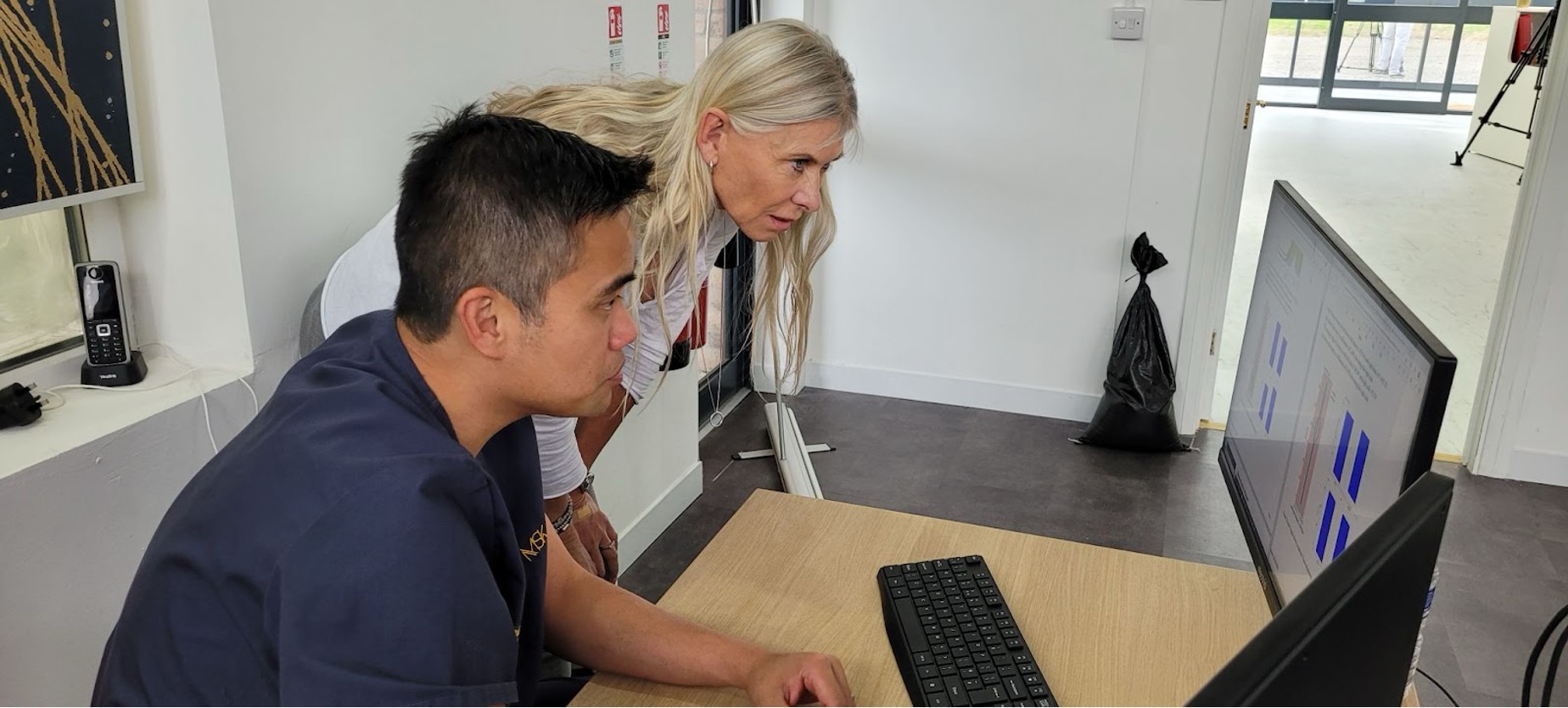Facial Pain: Symptoms, Causes, Treatment & Exercises
:format(webp)/cdn.mskdoctors.com/storage/2025/3/bXJZzsUysLB0FwT1Tt5gVmMb6OsMbl9k.jpg)
Key Takeaways
-
Facial pain manifests differently for each individual, ranging from sharp, stabbing sensations to persistent, dull aches.
-
Multiple factors can contribute to facial pain such as sinusitis, migraines, dental issues, and neurological disorders.
-
Some of the common treatment approaches are home remedies, over-the-counter medications, medical interventions, and natural alternatives.
-
Targeted exercises and relaxation techniques can help manage muscle tension and reduce facial pain.
-
MSK Doctors offers comprehensive and personalised facial pain treatment using advanced diagnostic technologies like MAI (Motion Artificial Intelligence).
Understanding and Managing Facial Pain
Facial pain refers to any discomfort felt in various parts of the face, including the forehead, eyes, jaw, or sinuses. It can manifest as headaches, sinus pain, or pain from dental issues that can significantly affect daily activities and overall quality of life.
Facial pain is a symptom rather than a condition itself, which shows the importance of identifying the underlying causes to treat it effectively.
Symptoms of Facial Pain
The symptoms of facial pain can range from sharp, stabbing pain to a persistent, dull ache that may be localized to a specific area or spread across multiple facial regions.
Patients often experience accompanying symptoms that extend beyond simple pain. These can include headaches, pressure around the eyes, jaw discomfort during chewing, increased sensitivity to touch or temperature, and in some cases, additional complications like dizziness or nausea.
|
Common Causes
Sinusitis and Infections
Sinusitis is a common cause of facial pain, resulting from inflammation of the sinuses. This can cause pressure and pain around the eyes, nose, and forehead. Infections, such as colds or flu, can also lead to similar symptoms. Treatment often involves decongestants, steam inhalation, and sometimes antibiotics if a bacterial infection is present.
Migraines and Headaches
Migraines can cause intense, throbbing pain, often on one side of the head, and may be accompanied by nausea or light sensitivity. Tension headaches, on the other hand, typically present as a dull, aching sensation around the forehead or temples.
Managing these types of headaches often requires a combination of medication, lifestyle changes, and stress management techniques.
Dental Issues
Toothaches, abscesses, or TMJ disorders can cause significant discomfort. Regular dental check-ups and good oral hygiene are key to preventing these issues. If you suspect a dental problem is causing your pain, consulting a dentist is the best course of action.
Neurological Disorders
Some facial pain is linked to neurological disorders, such as trigeminal neuralgia. This condition causes sudden, severe facial pain, often described as an electric shock. While less common, these disorders require specialised medical treatment, and early diagnosis can improve outcomes.
Treatment Options for Managing Facial Pain

Effective treatments for facial pain range from physical therapy to targeted injections.
Home Remedies
Applying a warm compress helps reduce tension and improve blood circulation, providing targeted pain relief. Steam inhalation is particularly effective for sinus-related discomfort, helping to clear nasal passages and reduce facial pressure.
Over-the-Counter Medications
Non-prescription pain relievers like ibuprofen and acetaminophen can alleviate pain and reduce inflammation. Decongestants and antihistamines provide relief for sinus-related symptoms. Always follow medication instructions and consult a healthcare professional if symptoms persist or worsen.
Medical Interventions
Prescription medications such as muscle relaxants or anti-inflammatory drugs can address conditions like TMJ disorders or severe migraines. Complex cases like trigeminal neuralgia may require advanced interventions including nerve blocks or surgical procedures.
Natural Alternatives
Acupuncture has demonstrated effectiveness in pain reduction, while herbal remedies like ginger and peppermint may offer additional relief. However, always consult a healthcare provider before starting any new supplement or alternative therapy to ensure safety and effectiveness.
Exercises for Relief
Consistent practice of targeted exercises can help manage facial pain by reducing muscle tension and improving flexibility. You can try these techniques during periods of increased stress or when symptoms begin to emerge.
Jaw Relaxation Techniques
Jaw tension significantly contributes to facial pain, especially for those with TMJ disorders or teeth grinding habits:
-
Gentle Jaw Movements: Slowly open and close your mouth, maintaining a relaxed jaw. Avoid clenching or grinding teeth to improve joint mobility.
-
Tongue Placement and Jaw Opening: Place your tongue behind your front teeth on the mouth's roof. Slowly open your jaw while keeping the tongue in place. Hold for a few seconds, then gently close. Repeat throughout the day to reduce tension.
Neck and Shoulder Stretches
Neck and shoulder tension can worsen facial pain:
-
Neck Tilts: Gently tilt your head toward one shoulder, holding for 15-30 seconds. Feel the stretch along the opposite neck side. Alternate sides to relieve tension.
-
Shoulder Rolls: Slowly roll shoulders forward and backward to loosen muscles and improve upper body circulation, potentially reducing referred facial pain.
Gentle Facial Massages
Massages can increase circulation and ease muscle tension:
-
Temple Massage: Apply gentle, circular fingertip pressure to temples to alleviate headache and sinus pain.
-
Jaw and Cheekbone Massage: Massage along the jawline and under cheekbones, focusing on tight or tender areas. It’s particularly beneficial for TMJ disorders.
Professional Guidance
While these exercises provide valuable self-management techniques, they are not a substitute for professional medical evaluation. Persistent or worsening facial pain requires expert assessment to identify underlying causes and develop a comprehensive treatment strategy.
Healthcare providers can offer personalised insights, potentially recommending specialised treatments, diagnostic tests, or targeted interventions that complement these exercises.
Your unique medical history, specific condition, and individual pain patterns demand a nuanced approach that extends beyond general exercise recommendations. The goal is not just temporary relief, but understanding and addressing the root causes of your discomfort.
Why Choose MSK Doctors for Your Facial Pain Treatment?

MSK Doctors offers expert diagnosis and advanced treatment options for facial pain relief.
At MSK Doctors, we recognise that each patient's experience is unique. We combine thorough diagnostic evaluations like MAI (Motion Artificial Intelligence) with innovative treatment strategies designed to meet your specific needs. Our approach goes beyond symptom management, focusing on identifying and addressing the root causes of your facial pain.
Comprehensive Care and Patient Empowerment

MSK Doctors provide in-depth assessments to create personalised treatment plans for facial pain.
Our compassionate team understands the physical and emotional challenges of living with facial pain. We prioritise collaborative care, listening carefully to your concerns and developing treatment plans that align with your personal health goals.
By providing ongoing support, detailed guidance, and access to a wide range of treatment options, we’re dedicated to helping you find your path to recovery and renewed well-being.
Take the first step towards pain-free living—schedule your personalised consultation with MSK Doctors today.
Frequently Asked Questions (FAQ)
What is facial pain?
Facial pain is discomfort felt in various parts of the face, including the forehead, eyes, jaw, or sinuses, which can manifest as headaches, sinus pain, or dental-related pain.
What are the most common causes of facial pain?
Common causes include sinusitis, migraines, tension headaches, dental issues like TMJ disorders, and neurological conditions such as trigeminal neuralgia.
When should I see a healthcare professional about facial pain?
Seek medical help if you experience persistent severe pain, sudden unexplained pain, associated symptoms like vision changes, inflammation, or if you have a history of neurological issues.
Are there home remedies for facial pain?
Yes, home remedies include applying warm compresses, steam inhalation, gentle exercises, and over-the-counter pain relievers.
How can MSK Doctors help me with my facial pain?
MSK Doctors offers personalised, comprehensive facial pain treatment using cutting-edge diagnostic technologies like MAI (Motion Artificial Intelligence), creating tailored plans that target the root cause of your pain.
:format(webp)/cdn.mskdoctors.com/storage/2025/5/hgH74n2NLXbN2EROC3N45aTdfUh1xKkM.jpg)
:format(webp)/cdn.mskdoctors.com/storage/2025/5/qf6zY2JVctL0BGJLEryU4lLIeRBsr5fC.jpg)
:format(webp)/cdn.mskdoctors.com/storage/2025/5/J26J2SuguZTzYNmqcI1EFk6a2wJsUF4a.jpg)
